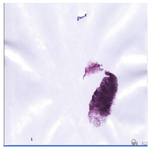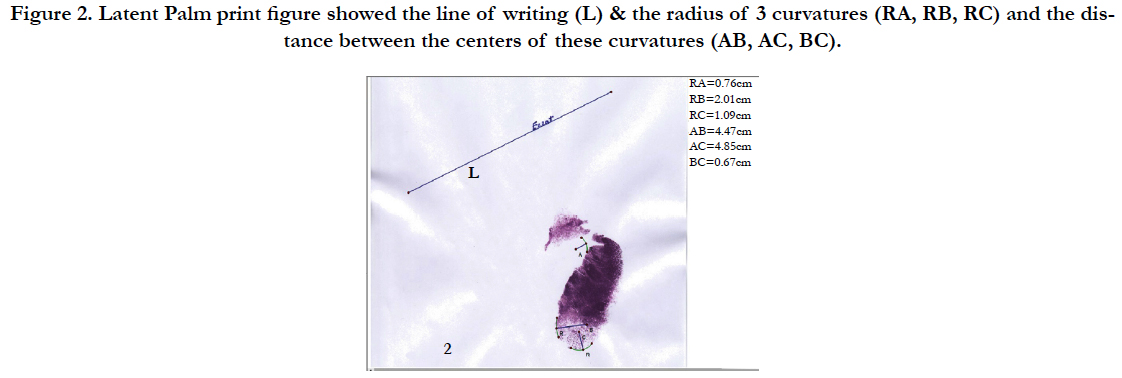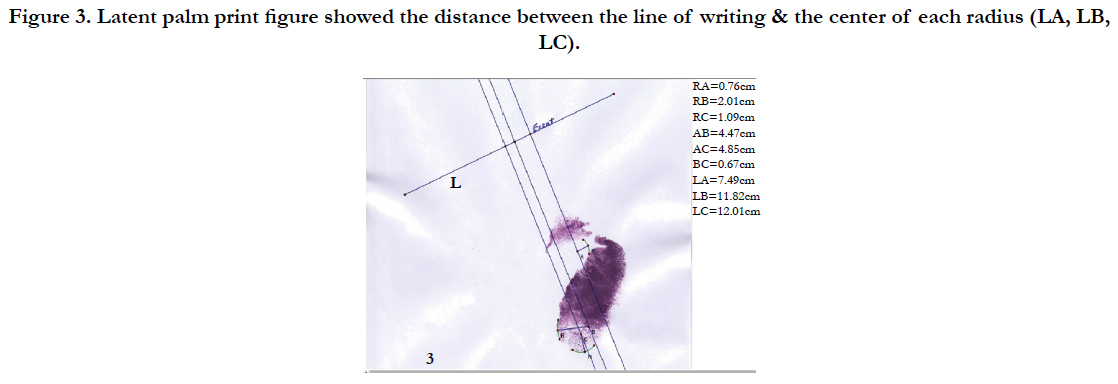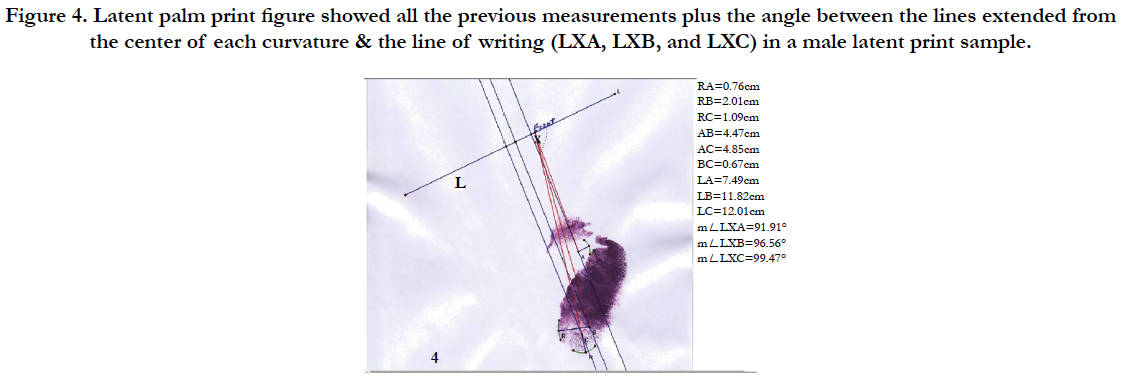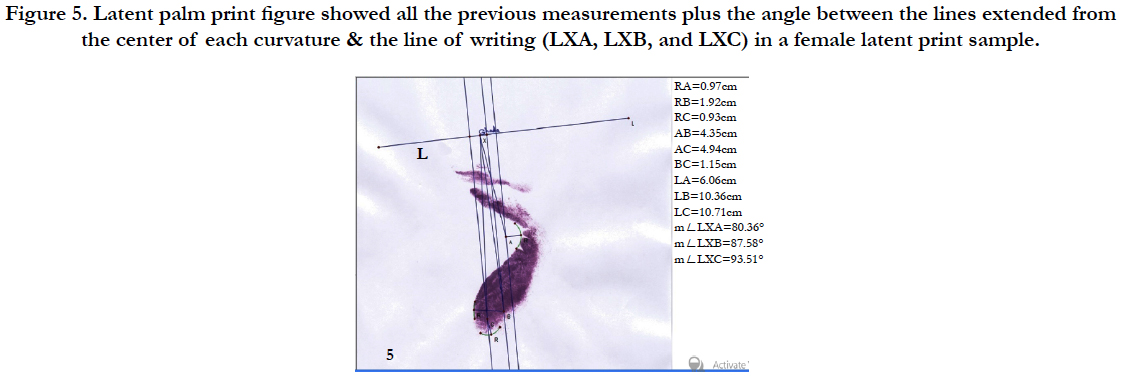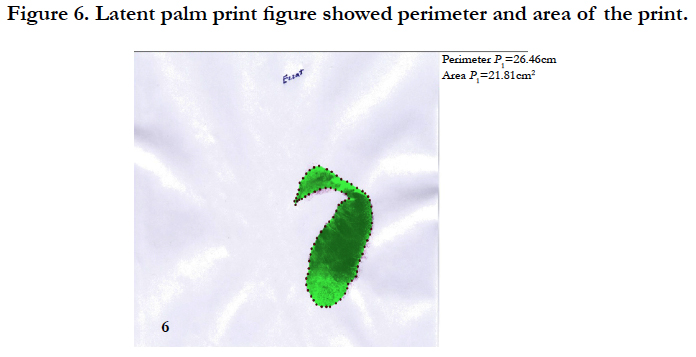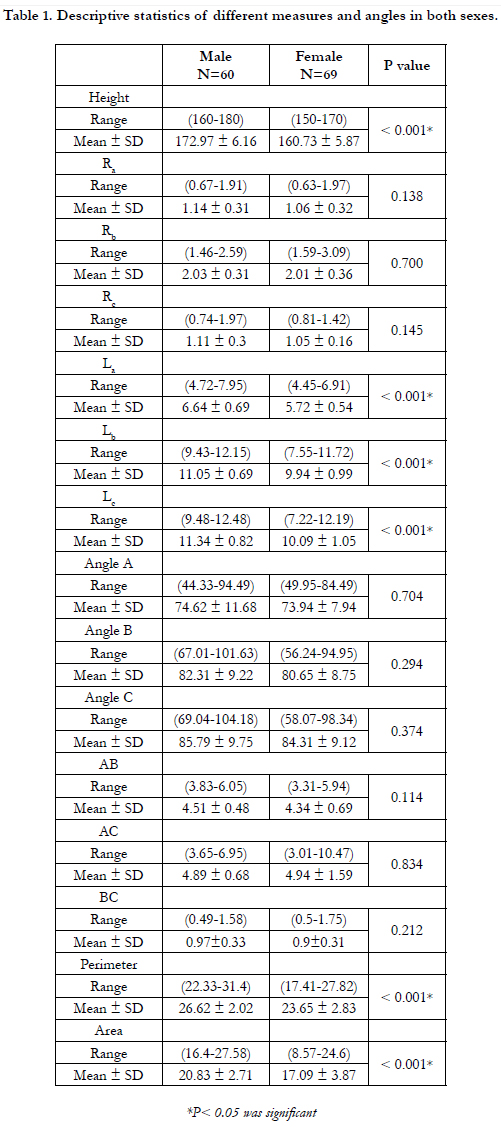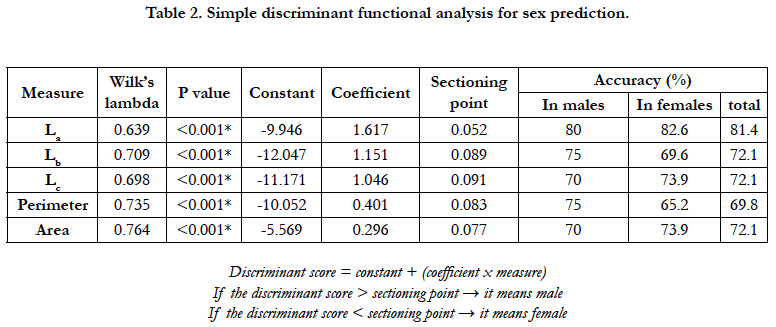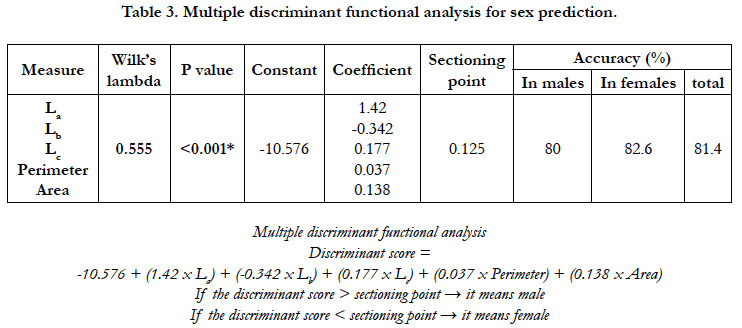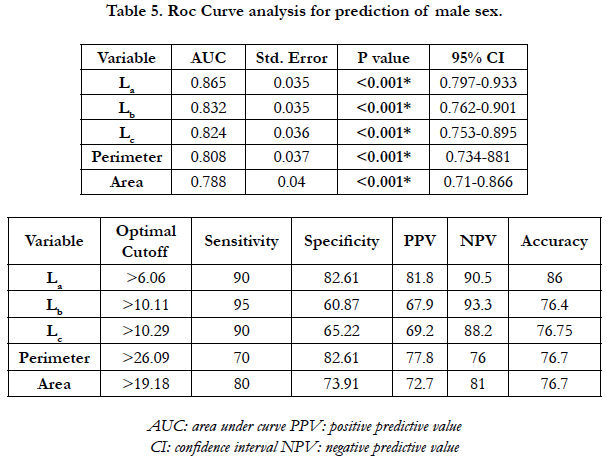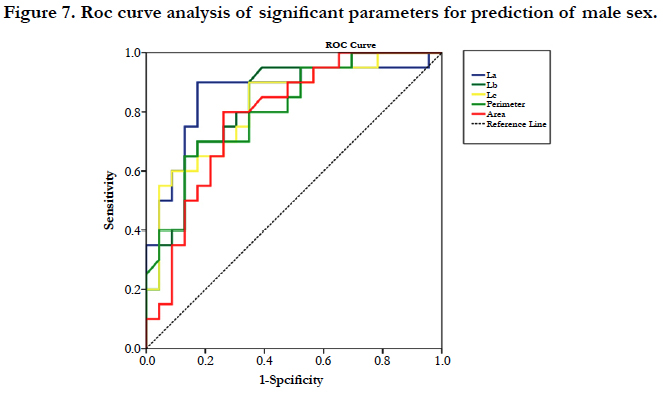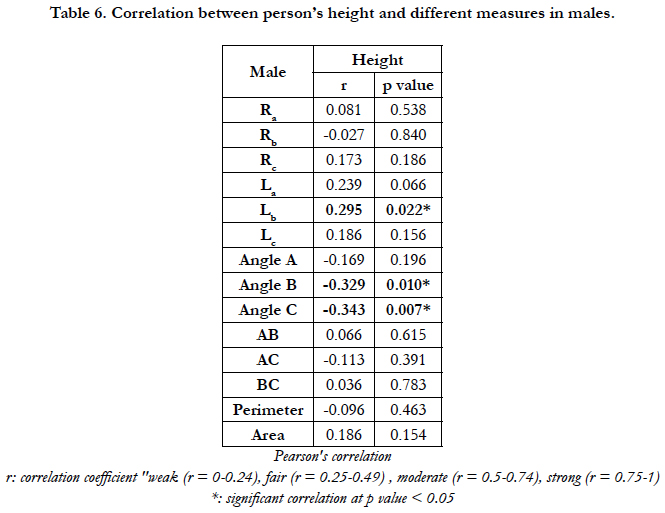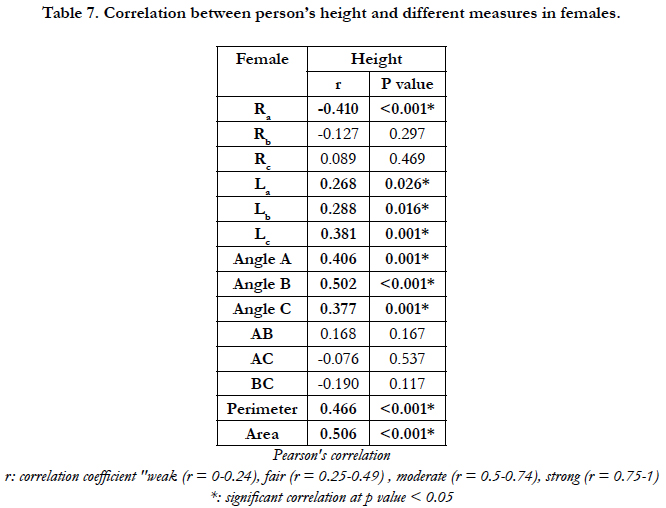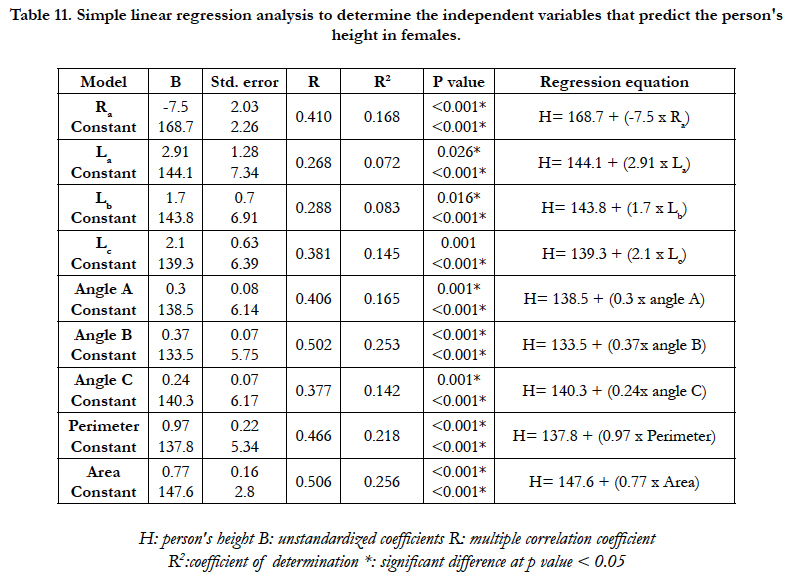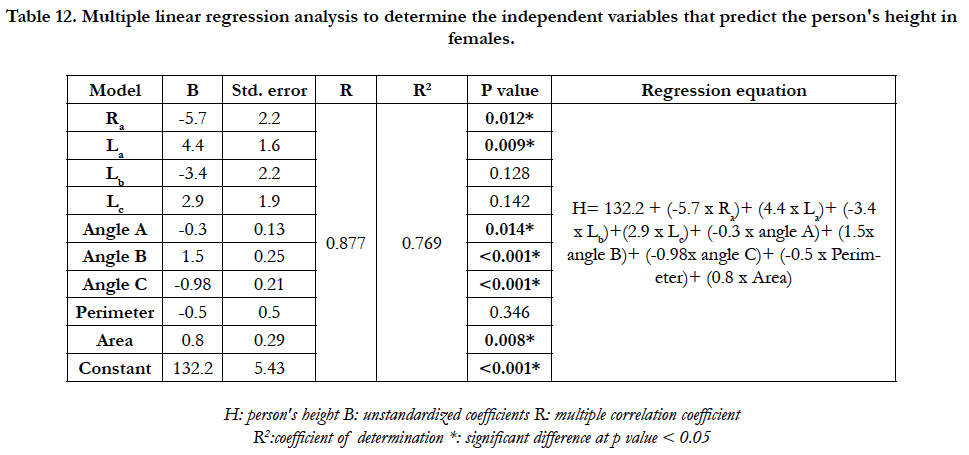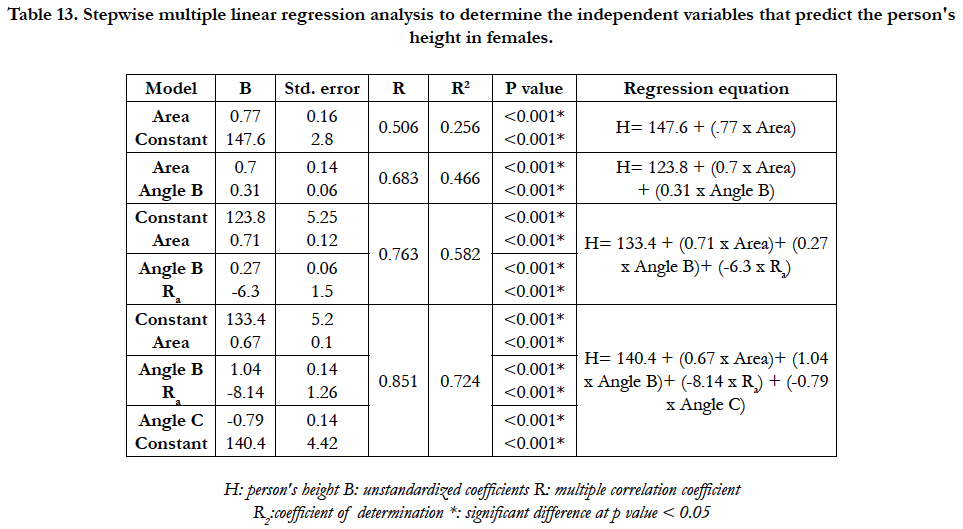Determination of Sex and Stature from Latent Palm Prints Present on Documents in Egyptian Population Sample
Abd-elaleem SA1*, Hassan EI1, Asem Mohammed MM2
1 Assistant Professor of Forensic Medicine and Toxicology, Minia University, Egypt.
2 Lecturer of Forensic Medicine and Toxicology, Minia University, Egypt.
*Corresponding Author
Shereen abd-elhakim Abd-elaleem , M.B.B.CH. M.Sc. PhD,
Assistant Professor of Forensic Medicine and Toxicology, Minia University, Egypt.
Email: shery_ft1978@yahoo.com
Received: June 15 2017; Accepted: July 17, 2017; Published: July 19, 2017
Citation: Abd-elaleem SA, Hassan EI, Asem Mohammed MM (2017) Determination of Sex and Stature from Latent Palm Prints Present on Documents in Egyptian Population Sample. Int J Forensic Sci Pathol. 5(4), 360-369. doi: dx.doi.org/10.19070/2332-287X-1700079
Copyright: Abd-elaleem SA© 2017. This is an open-access article distributed under the terms of the Creative Commons Attribution License, which permits unrestricted use, distribution and reproduction in any medium, provided the original author and source are credited.
Abstract
Palm and finger prints are considered one of the best methods of absolute identification of an individual. So the aim of this study was to determine sex and stature from the latent palm prints present on documents. This study was done on 129 persons (60 males and 69 females) and they were asked to put their signatures on a blank paper. After that, ninhydrin solution was sprayed over the paper. After appearance of the latent print; the paper is scanned with its original size, then the scanned picture was opened with Geometer’s sketchpad software. Stature and fourteen parameters were measured. As regards sex determination; there was a significant increase in LA, LB, LC, perimeter and area in males than females (P <0.001). By stepwise discriminant functional analysis, the most accurate predictors of sax were LA and area. As regards stature estimation, the most predictors of stature by stepwise regression analysis in males were Angle C and LB, while in females the most predictors were area, angle B, RA and Angle C. Finally, it was confirmed that latent palm prints on documents are helpful in sex and stature determination in Egyptian population sample through measurement of different distances and angles.
2.Introduction
3.Subjects and Methods
3.1 Subjects
3.2 Materials
3.3 Methods
3.4 Statistical Analysis
4.Results
5.Discussion
6.Conclusion & Recommendations
7.References
Keywords
Palm Print; Latent; Ninhydrin; Sex; Stature.
Introduction
Palm and fingerprints are viewed as one of the best methods of absolute identification of a person as they are exceptional, unique and perpetual by nature [1]. Palm print is a mix of two parts, the palmar friction ridges and the palmar flexion creases. Palmar friction ridges are the corrugated skin patterns with sweat glands yet no hair or oil glands [2].
Discontinuties in the epidermal ridge patterns are known as the palmar flexion creases. Flexion wrinkles (creases) appear before the arrangement of friction ridges during the embryonic skin development stage, and both elements are guaranteed to be changeless, lasting and unique to an individual [3]. There are three major types of flexion wrinkles that are most obviously unmistakable. These types are distal transverse, proximal transverse and radial transverse wrinkles. Based on these wrinkles, three palm print locales are charachterized: interdigital, thenar and hypothenar [4].
On touching or grasping an object, a trace of the friction ridge skin may be found. Based on the fact that, the hypothenar area comes in contact with the supporting surface while writing, drawing or signing, an impression of part of the hand and/ or the palm can be found [5].
Since sweat is apparently a coloureless fluid, the prints so left behind are not visible to the naked eye, the visibility of the prints are enhanced by various chemical methods and reagents. Analysis of finger and palm prints at the crime scene is vital to identify the suspect and establish a crime [6].
Latent prints are impressions produced by the ridged skin, known as friction ridges, on human fingers, palms, and soles of the feet. According to the study of [2], about 30% of the latent prints recovered from crime scenes are from palms. Hence, there is a great need of palm print databases worldwide. So that, the prints obtained from the crime scene can be matched with the suspects to confirm their involvement in crime [7].
Many researchers have explored the possibility of sex and stature identification from finger prints. Owed to the few number and scanty data in the utilization of latent palm print in individual identification, the objective of this study was to determine sex and stature from latent palm prints present on documents in a sample of Egyptian population in Minia Governorate.
This study was carried out on right handed 129 individuals (60 males & 69 females), with their age ranging from (18-30 years). Subjects were randomly selected from the Forensic Medicine & Toxicology department- faculty of Medicine-Minia University in Minia Governorate- Egypt, as medical students, technicians, and faculty employees in May 2016. Informed written consents were taken from all participants and the followed procedures were in accordance with the ethical standards of Minia University Ethical Committee. Only individuals without any medical history of right hand problems as congenital hand anomalies, previous burns, burn contractures, previous surgical scars, ulnar nerve palsy (hypothenar wasting), malunited fifth metacarbal fractures and post axial polydactly, foot and spine problems (as it hinders stature estimation) were recruited in this study.
Gloves, small sprayer bottle, steam iron, paper towels, blue pen, blank white paper and Ninhydrin solution. This solution was prepared by dissolving 5grams of Ninhydrin powder in 75ml of ethyl alcohol according to the study of Keeling et al., [8]. The chemical substances were obtained from El-Nasr Pharmaceutical Company - Egypt.
Stature was estimated in all individuals included in this study. Then, the individuals were asked to sit on chair at ease. After giving a blank white paper and blue pen to the subjects, they were asked to put the paper on a table followed by putting their signature on this paper at calm atmosphere [4].
After the individual finished writing, the papers are carefully handled and put at room temperature. Then, Ninhydrin solution was sprayed over the papers. Appearance of prints with Ninhydrin solution occurs very slowly at room temperature and at humidity. This could be accelerated by increasing the temperature. In this study, we used an ordinary steam iron with the specimen (blank paper with a signature) sandwiched between paper towels according to Wu et al., [9]. Latent prints appeared within a few minutes (5-10 minutes).
After the appearance of latent prints, each blank paper was scanned with its original size using colour image scanner (Canoscan- Lide 120- Canon INC-Vietnam), then we opened the scanned picture with a software program called Geometer's Sketchaped version 5 (Figure 1). The steps of the method that were used in this study were according to the manual method of Amit [10].
Figure 1. Figure of a latent palm print after scanning and its appearance by Geometer's Sketchaped software program.
Firstly we drew the line of writing (L) and put 3 points representing each curvature, then reconstruction of each curvature with its radius was done. Measurement of the radius of each curvature (RA, RB, RC) and the distance between the centers of curvatures (AB, AC, BC) were made using the soft ware program (Figure 2).
Figure 2. Latent Palm print figure showed the line of writing (L) & the radius of 3 curvatures (RA, RB, RC) and the distance between the centers of these curvatures (AB, AC, BC).
From the line of writing, we drew a perpendicular line that cut the center of each radius, and then we measured the distance between the line of writing and the center of each radius (LA, LB, LC) using the software program (Figure 3). Then we drew a line from the center of each curvature cutting the line of writing at the beginning of the word (Point X) and then measurement of the angle between them (LXA (angle A), LXB (angle B), LXC (angle C) was done (Figures 4 & 5). Marking of the boundaries of the print and measuring its perimeter and area were done using the software program (Figure 6). All these measurements were done by the use of software program called Geometer's Sketchaped version 5, and so we did not use a manual ruler in this study.
Figure 3. Latent palm print figure showed the distance between the line of writing & the center of each radius (LA, LB, LC).
Figure 4. Latent palm print figure showed all the previous measurements plus the angle between the lines extended from the center of each curvature & the line of writing (LXA, LXB, and LXC) in a male latent print sample.
Figure 5. Latent palm print figure showed all the previous measurements plus the angle between the lines extended from the center of each curvature & the line of writing (LXA, LXB, and LXC) in a female latent print sample.
The data were analyzed using SPSS statistical package version 20. Mean and standard deviations were obtained for stature and all 14 measurements of the latent palm prints of both sexes. Student-t test was done to establish the presence of significant sexual differences. Discriminant function analysis for sex prediction was made. Roc (receiver operating characteristic) curve analysis was done to obtain the optimal cut off value, sensitivity, specificity of the most significant parameters in sex prediction. Correlation between stature and different measurements was tested using Pearson's correlation. Linear regression analysis was performed to predict stature in both sexes.
Results
This study revealed that there was a significant sexual difference in 5 measurements only (LA, LB, LC, perimeter and area) (P< 0.05) (Table 1). By simple discriminant analysis for sex prediction, the most predictable parameter was LA (its total percentage of accuracy was 81.4%) followed by LB, LC and area. Their total percentage of accuracy was the same which was 72.1% (Table 2).
By multiple discriminant analysis, combination of the above 5 significant parameters was done and gave a percentage of accuracy of 80% in males and 82% in females (Table 3). Finally, by stepwise multiple discriminant analysis, there was one model of the use of combination of LA and area for sex prediction, this model gave a total percentage of accuracy of 81.4 % (Table 4). By Roc curve analysis for sex prediction, if the cutoff value was > (6.06, 10.11, 10.29, 26.09 and 19.18) for (La, LB, LC, perimeter and area respectively), the sex was male and vice versa (Table 5, Figure 7).
There was a significant +ve fair correlation between male height and LB measurement and significant –ve fair correlation between height and angle B & C (Table 6). While, in females, there was a significant +ve fair to moderate correlation between height and LA, LB, LC, angle A, B, and C , perimeter and area of latent palm print. Also, there was a significant –ve fair correlation between height and RA (Table 7).
By simple linear regression analysis, 3 models were used to predict stature in males. The most predictable models were model of Angle C (R=0.343 & R2=0.118) and model of angle B (R=0.329 & R2 =0.108), while, in females, 9 models were used to predict stature. Area (R=0.506 & R2=0.256), angle B (R=0.502 & R2 = 0.253) and perimeter (R=0.466 & R2=0.216) were the most predictable models in females (Table 8, 9).
Table 8. Simple linear regression analysis to determine the independent variables that predict the person's height in males.
Table 9. Multiple linear regression analysis to determine the independent variables that predict the person's height in males.
Combination of (LB, angle B and C) was used to predict stature in males by multiple linear regression analysis (R=0.438 & R2 =0.192). While, in females, combination of (RA, La, LB, LC, angle A, B and C, perimeter and area) was used to predict stature (R= 0.877 & R2= 0.769) (Table 10, 11). Table 12 showed 2 models that were used to predict stature in males by stepwise linear regression, The most predictable one was, combination of angle C & LB (R= 0.437 & R2= 0.191). In females, four models were used and the most predictable one was combination of area, angle B, C, and RA) (R= 0.851 & R2=0.724) (Table 13).
Table 10. Stepwise multiple linear regression analysis to determine the independent variables that predict the person's height in males.
Table 11. Simple linear regression analysis to determine the independent variables that predict the person's height in females.
Table 12. Multiple linear regression analysis to determine the independent variables that predict the person's height in females.
Table 13. Stepwise multiple linear regression analysis to determine the independent variables that predict the person's height in females.
Discussion
Forensic anthropology is a branch of physical anthropology that was used in crimes and its investigations. Personal identification is an integral part of the crime investigation in cases of mass disaster, where mutilated and disintegrated body parts are frequently found. In many crime scenes, latent prints including palm and finger prints were found [11].
Latent prints (finger and palm prints) are the impressions of the dermal friction ridges present on the palmar aspect of the hand. Palm prints are highly individualistic and encountered at crime scene and also, on documents [12]. Palm prints undoubtedly are the most reliable and accepted evidence in the court of law. It may be because of disease, weather, age, or wearing gloves in hands, palm prints don't occur on documents during writing [13].
In this study, efforts have been made to identify sex and stature of a person from latent palm prints present on documents in a sample of Upper Egypt population in Minia Governorate. The authors of this study used Ninhydrin solution to develop latent palm prints as it is the least expensive and the most reliable method. Upon contact with this solution, Ninhydrin reacts with free amino acids in the skin and causes a deep to purple stain within a short time period [8].
Ninhydrin (2,2-dihydroxyindane- 1,3-dione) is a chemical substance used to detect ammonia or primary and secondary amines. It is the most commonly substance used to detect fingerprints, as the terminal amines of lysine residues in peptides and proteins sloughed off in fingerprints react with ninhydrin [8]. Ninhydrin can be used to monitor deprotection in solid phase peptide synthesis (Kaiser test), it is also used in amino acid analysis of proteins. When ninhydrin reacts with amino acids, the reaction releases CO2. This reaction has been used to release the carboxyl carbons of bone collagen from ancient bones for stable isotope analysis [9].
The results of this study revealed the presence of significant sexual difference in stature and only 5 measured parameters (LA, LB, LC, perimeter, and area). These parameters are significantly high in males. These results are not in agreement with the results of Amit [10] who studied the determination of sex in Indian population from latent palm print on documents. Amit [10] research included only 60 subjects while this present paper included 129 subjects. His results revealed that all the measured parameters were highly significant in males than females. Also, he used black powder to facilitate the development of latent prints and his study doesn't include any discriminant function analysis to predict sex.
The method and results of this present study were also different from the study of Sumeel et al., [14]. Their study was on the use of palm print length and breadth to determine sex and stature in North and South Indians. Their study revealed that there was a significant sexual difference only in hand print length and also it was the most predictable parameter in estimation of stature in both sexes.
Amit et al., [15] introduced a study to identify sex from ridge density of latent palm print of North Indian population. Their study showed that females had a greater ridge density than males. Their method was also completely different from our study.
Regarding estimation of stature from latent palm prints in this present study, there was a significant correlation between stature and some of the measured parameters in both sexes as discussed before in the results. By simple linear regression analysis, the most predictable parameters in estimation of stature in males were angle B and C. While, in females, angle B, perimeter and area were the most predictable parameters.
On comparing our results with those done in Egyptian population samples, it was found that the mean of the stature in our sample (172.97 ± 6.16cm for males and 160.73 ± 5.87cm for females) was higher than that of Melad [16] (167.89 ± 5.86cm in males and 156.96 ± 6.64cm in females). While, it was lower than that of the study of Habib and Kamal [17] (174.61 ± 7.34cm in males and 160 ± 5.45cm in females). These differences may be due to the differences in age range. Cline et al., [18] mentioned that with increasing age, a narrowing of the spinal discs with decrease in the spinal length occur. The study of the previous authors used the print of the whole hand and its measurements to estimate stature and their results revealed that the hand print length was the most predictable measurement in estimation of stature in both sexes. Their method and results in estimation of stature were not coping with our present study.
Piti et al., [19] introduce a study to estimate stature from hand print measurements in Thias. Their results revealed that hand print length followed by palm length were the most predictable measurements in estimation of stature in both sexes. Their study was did not match ours.
Conclusion & Recommendations
From this study, it is concluded that determination of sex and stature provide important evidence about the suspect during crime scene investigation. In this study, we tried to define sex and stature from latent palm prints on documents in Upper Egypt population sample. The most predictable model in determination of sex by stepwise discriminant analysis was the combination of LA and area (with total percentage of accuracy 81.4%) and if the cutoff value of LA, LB, LC, perimeter and area were more than 6.06, 10.11, 10.29, 26.09, 19.18 respectively, the sex was male. Also, latent palm print is helpful in prediction of stature particularly in females and the most predicted parameters in females were area, angle B, RA and angle C.
Finally, this study is limited to 129 subjects for analysis, thus it is recommended to do further studies on larger number of subjects and among different population and age groups. Also, it is advised to use this study in investigations of crime scene as it can decrease the decision time and its identical role in identification of suspect, especially when facilities for DNA analysis are not available.
References
- Tanuj K, Kewal K, Aparna KR, Shyamsundar S (2013) Is there a sex difference in palm print ridge density? Med Sci Law. 53(1): 33-39.
- Jain AK, Feng J (2009) Latent palm print matching. IEEE Trans Pattern Anal Mach Intell. 31(6): 1032-47.
- Acree MA (1999) Is there a difference in fingerprint ridge density? Forensic Sci Int. 102(1): 35-44.
- Chaudhary R, Pant SK (2004) Identification of authorship using lateral palm print - a new concept. Forensic Sci int. 141(1): 49-57.
- Nayak VC, Rastogi P, Kanchan T, Lobo SW, Nayak S, et al., (2010) Sex differences from fingerprint ridge density in the Indian population. J Forensic Leg Med. 17(2): 84-6.
- Lalit K, Sandeep A, Rajesh G, Amit P, Mishra VK (2013) Gender determination using fingerprints in region of Uttarakhand. J Indian Acad Forensic Med. 35(4): 308-311.
- Rae L, Gentles Dennis, Farrugia J (2013) An investigation into the enhancement fingermarks in the blood on fruits and vegetables. J sci justice. 53(3): 321-327.
- Keeling CI, Nelson DE, Slessor KN (1999) Stable carbon isotope measurements of the carboxyl carbons in bone collagen . Archaeometry. 41(1): 151- 164.
- Wu X, Zhang D, Wang K (2003) Fisherpalms based palm print recognition. pattern recogn lett. 24(15): 2829-2838.
- Amit Chauhan, Jyothi S, Ritu S (2015) Determination of sex from the latent palm prints present on documents. Forensic Res. 5(4): 148-153.
- Rastogi P, Nagesh KR, Yoganarasimha K (2008) Estimation of stature from hand dimensions of North and South Indians. Leg Med. 10(4): 185-189.
- Eboh Dennis EO (2013) Fingerprint patterns in relation to gender and blood group among students of delta state University, Abraka, Nigeria. J exper clin Anatomy. 12(2): 82-86.
- Esperanza GR, Concepcion AR, Luis EHH, Jose LRB (2011) Distribution of minutiae in the fingerprints of a sample of the Spanish population. Forensic Sci Int. 208(1-3): 79-90.
- Sumeel S, More S, Malani A, Shastikaa N (2013) To study the correlation between stature and palm prints among North Indians and South Indians. J Forensic Med Sci Law. 22(1): 1-7.
- Amit Chauhan, Singh Jyoti, Kushwaha KP (2015) An evaluation: sexing from the ridge density of latent palm prints of North Indian Population. Res J Recent Sci. 4: 73-75.
- Melad G (2015) Estimation of stature from handprint dimensions in Egyptians population. J Forensic Legal Med. 34: 55-61.
- Habib SR, Kamal NN (2010) Stature estimation from hand and phalanges lengths of Egyptians. J Forensic Leg Med. 17(3): 156-60.
- Cline MG, Meredith KE, Boyer JT, Burrows B (1989) Decline of height with age in adults in a general population sample: estimating maximum height and distinguishing birth cohort effects from actual loss of stature with aging. Hum Biol. 61(3): 415-25.
- Piti L, Montip T, Suda Ri (2013) Estimation of stature from hand measurements in Thais. SDU Res J. 6(1): 37-47.


